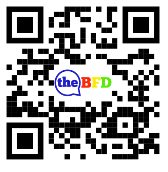Table of Contents
This series is designed to help people to understand modern technology, and become more confident in using computing devices. It is not designed to educate experts.
The author is involved in tutoring older students at SeniorNet, a New Zealand wide organisation. SeniorNet hopes that students will feel more confident in using their computing devices as a result of the learning opportunities offered. This series of articles shares that hope.

Scanning the above code with your smart phone (provided it has the required smarts) will load the URL of that well-known bastion of all things rainbow, theBFD.co.nz. If you click on the URL, through the magic of modern technology you will have that site presented to you in a form suitable to the viewing device. It’s so magic, it’s almost like witchcraft. Wow!

What is this magic, and can we use it in our everyday lives? A QR code (an initialism for quick response code) is a type of matrix bar code (or two-dimensional bar code) invented in 1994 by the Japanese automotive products company Denso Wave. A bar code is a machine readable optical label that can contain information about the item to which it is attached. In practice, QR codes often contain data for a locator, identifier, or tracker that points to a website or application.
It can contain information such as an internet site address, or other information. It has been used recently (not by me) to provide a record of where a person has been in relation to Covid-19 infections. In fact, anywhere that a small amount of information is to be supplied to a reader (such as a smart phone) is a possible use case.
Does your smart phone have this already built in? Try pointing your camera app at the QR code at the top of this article, and see what happens. Most modern up market phones should read the code. If not, you can download and install a scanner from your phone’s app store.
Search for QR Code scanner, choose one of the free alternatives and install as for any other app. Open the app and scan the QR code. It should work. I use QR Code Reader from Scan Mobile, whose Privacy Policy can be found here. While the policy appears innocuous enough, do I believe it? Probably not fully, and possibly Google is also scraping data from my interactions. But my gain from using the app outweighs the possible data harvesting, so I can live with it. I also note the app works when my phone is detached from the internet, suggesting the data harvesting isn’t as all encompassing as with some apps.
To make your own QR codes, go to one of the many services available. I’ve used QR Code Monkey for this article, but a quick search for QR Code Creator will bring up a plethora for you to choose from. This site will produce codes for URL, text, email, phone, SMS, Vcard, Wi-Fi and more.
Some uses of this for Joe and Joan Public could be:
Print your home Wi-Fi login details for visitors. Paste it on the back of a picture for quick scanning when those rellies need your internet.
Place a QR code in your phone with your contact details. Scanning this loads your contact details into your visitor’s phone.
List contents of storage boxes (either as printed lists or group photos) and place this in the cloud (Google Drive or a similar service). Use the URL and make a QR code label. Then scan the label to see the box contents.

Find online manuals for your seldom used gadgets. Then print the URL for the manual, and attach a QR code to the back of the gadget. Very handy for seldom used manuals.
Political campaigns ====>>>
Really, your use of these codes is limited only by your imagination.









